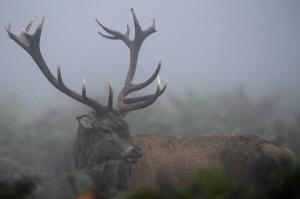Too many wild deer are roaming England's forests. Can promoting venison
to consumers help?
 Send a link to a friend
Send a link to a friend
 [November 12, 2024] By
SYLVIA HUI [November 12, 2024] By
SYLVIA HUI
WINCHESTER, England (AP) — In the
half-light of dusk, Martin Edwards surveys the shadows
of the ancient woodland from a high seat and waits. He
sits still, watching with his thermal camera.
Even the hares don’t seem to notice the deer stalker
until he takes aim. The bang of his rifle pierces the
stillness. He’s killed a buck, one of many wild deer
roaming this patch of forest in Hampshire, southern
England.
Edwards advocates humane deer management: the culling of
deer to control their numbers and ensure they don’t
overrun forests and farmland in a country where they no
longer have natural predators. For these advocates,
shooting deer is much more than a sport. It’s a
necessity because England's deer population has gotten
out of control.
There are now more deer in England than at any other
time in the last 1,000 years, according to the Forestry
Commission, the government department looking after
England’s public woodland.
That has had a devastating impact on the environment,
officials say. Excessive deer foraging damages large
areas of woodland including young trees, as well as the
habitats of certain birds like robins. Some landowners
have lost huge amounts of crops to deer, and
overpopulation means that the mammals are more likely to
suffer from starvation and disease.

“They will produce more young every year. We’ve got to a
point where farmers and foresters are definitely seeing
that impact,” said Edwards, pointing to some young hazel
shrubs with half-eaten buds. “If there’s too many deer,
you will see that they’ve literally eaten all the
vegetation up to a certain height.”
Forestry experts and businesses argue that culling the
deer — and supplying the meat to consumers — is a double
win: It helps rebalance the ecosystem and provides a
low-fat, sustainable protein.
While venison — a red meat similar to lean beef but with
an earthier flavor — is often perceived as a high-end
food in the U.K., one charity sees it as an ideal
protein for those who can’t afford to buy other meats.
“Why not utilize that fantastic meat to feed people in
need?” said SJ Hunt, chief executive of The Country Food
Trust, which distributes meals made with wild venison to
food banks.
Pandemic population boom
An estimated 2 million deer now roam England’s forests.
The government says native wild deer play a role in
healthy forest ecosystems, but acknowledges that their
population needs managing. It provides some funding for
solutions such as building deer fences.
But experts like Edwards, a spokesman for the British
Association for Shooting and Conservation, believe
lethal control is the only effective option, especially
after deer populations surged during the COVID-19
pandemic.
The pandemic was a boon to deer because
hunters, like everyone else, stayed home and the
restaurant market — the main outlet for venison in the
U.K. — vanished overnight.
[to top of second column] |

Deer rut in Bushy Park south west London , Friday, Oct. 18, 2024.
Wild deer numbers have dramatically multiplied in recent decades and
there are now more deer in England than at any other time in the
last 1,000 years, according to the Forestry Commission, the
government department looking after England's public woodland. (AP
Photo/Alastair Grant)
 “There were no sales of venison and
the price was absolutely on the floor,” said Ben Rigby, a leading
venison and game meats wholesaler. “The deer had a chance to breed
massively.”
Rigby’s company now processes hundreds of deer a week, turning them
into diced venison or steaks for restaurants and supermarkets. One
challenge, he said, is growing the domestic appetite for venison so
it appears on more dinner plates, especially after Brexit put new
barriers up for exporting the meat.
“We’re not really a game-eating nation, not like in France or
Germany or Scandinavia,” he said. “But the U.K. is becoming more and
more aware of it and our trade is growing.”
From the forest to the table
Shooting deer is legal but strictly regulated in England. Stalkers
must have a license, use certain kinds of firearms and observe open
seasons. They also need a valid reason, such as when a landowner
authorizes them to kill the deer when their land is damaged. Hunting
deer with packs of dogs is illegal.
Making wild venison more widely available in supermarkets and beyond
will motivate more stalkers to cull the deer and ensure the meat
doesn’t go to waste, Edwards said.
Forestry England, which manages public forests, is part of that
drive. In recent years it supplied some hospitals with 1,000 kg (1.1
tons) of wild venison, which became the basis of pies and casseroles
popular with patients and staff, it said.
The approach appears to have been well received, though it has
attracted some criticism from animal welfare group PETA, which
advocates veganism.
Hunt, the food charity chief, said there’s potential to do much more
with the meat, which she described as nutritious and “free-range to
the purest form of that definition.”
Her charity distributed hundreds of thousands of pouches of venison
Bolognese meals to food banks last year — and people are hungry for
more, she said.

She recalled attending one food bank session where the only protein
available was tinned sardines, tinned baked beans and the venison
meals.
“There were no eggs. There was no cheese. That’s all that they could
do, and people were just saying, ’Thank you, please bring more (of
the venison),” she said. “That’s fantastic, because people realize
they’re doing a double positive with helping the environment by
utilizing the meat as well.”
All contents © copyright 2024 Associated Press. All rights reserved |